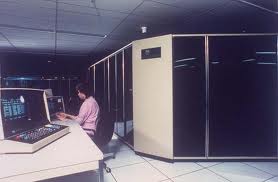-
1980
Hardware Description
In 1980, the successor to the Cyber 203, the Cyber 205 was announced. The UK Meteorological Office at Bracknell, England was the first customer and they received their Cyber 205 in 1981. The Cyber 205 replaced the STAR vector pipeline with redesigned vector pipelines: both scalar and vector units utilized ECL gate array ICs and were cooled with Freon. Cyber 205 systems were available with two or four vector pipelines, with the four-pipe version theoretically delivering 400 64-bit MFLOPs and 800 32-bit MFLOPs. These speeds were rarely seen in practice other than by handcrafted assembly language. The ECL gate array ICs contained 168 logic gates each,[6] with the clock tree networks being tuned by hand-crafted coax length adjustment. It is worth noting that the instruction set would be considered V-CISC (very complex instruction set) among modern processors. Many specialized operations facilitated hardware searches, matrix mathematics, and special instructions that would enable decryption. The original Cyber 205 was renamed to Cyber 205 Series 400 in 1983 when the Cyber 205 Series 600 was introduced. The Series 600 differed in memory technology and packaging but was otherwise the same. The Cyber 205 architecture evolved into the ETA10 as the design team spun off into ETA Systems in September 1983. A single four-pipe Cyber 205 was installed. All other sites appear to be two-pipe installations with final count to be determined.
-
Model Number:
Cyber 205 -
Manufacturer:
-
Hardware Type:
Computer - SuperComputer -
Manufacture Year:
1980 -
More Info:
-
We recognize our sponsors starting at $1 per entry.
Learn more at https://www.ithistory.org/benefits

